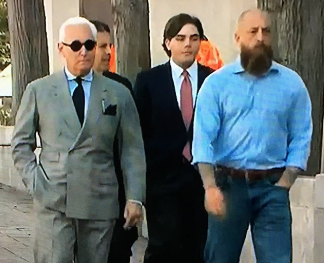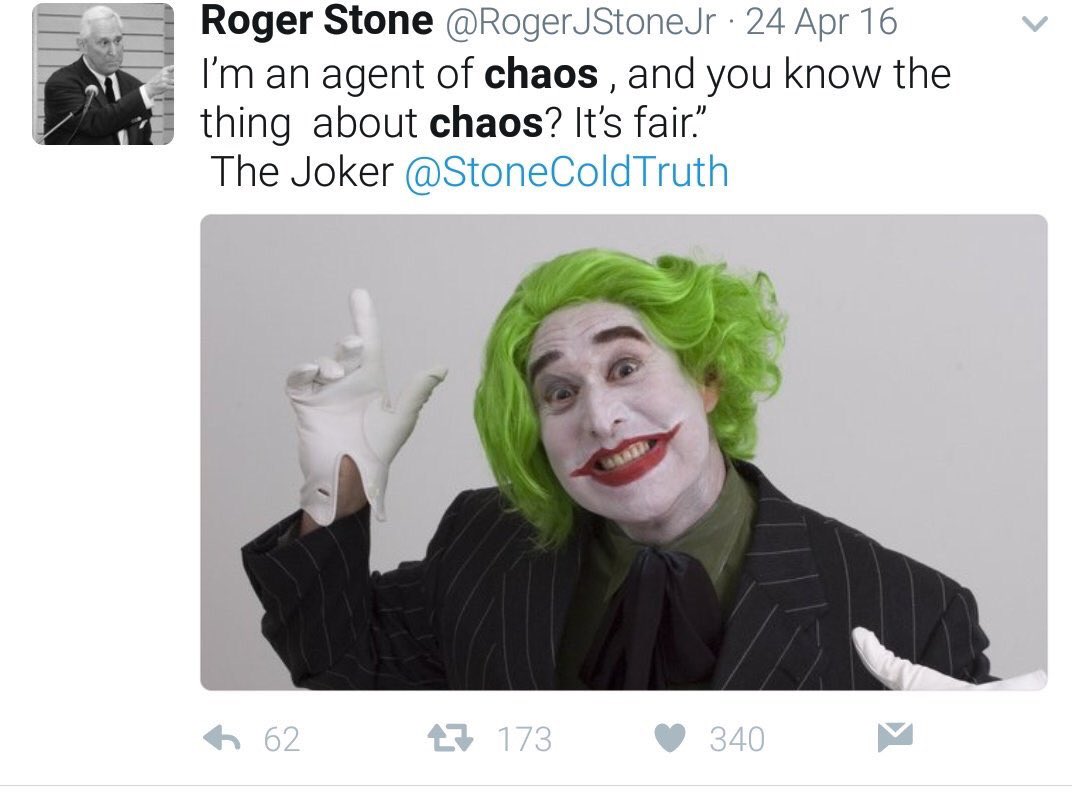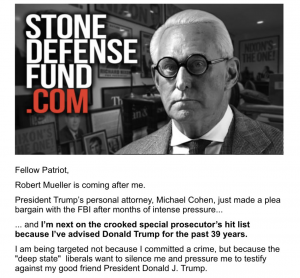The Narrative and Legal Tensions Set on Day One of Roger Stone’s Trial
I tried to travel to DC to cover the Roger Stone trial, but it didn’t happen. So I’m working second-hand to get details I’d like to have.
But I’ve got three questions from day one of Roger Stone’s trial that go to both the narrative tension prosecutors are setting and, probably, some legal traps as well. I won’t lay all of them out, but here are three.
Aaron Zelinsky introduces only the calls on which (prosecutors claim) they don’t know what happened
Aaron Zelinsky, one of the only remaining Mueller prosecutors still on this team, did the opening. He went after Trump from the start, making it clear that Stone lied to protect Trump. He described previously unknown calls between Stone and Trump on June 14 — after the WaPo reported on the DNC hack, on June 30 — after Guccifer 2.0 posted an FAQ claiming not to be Russian, and on August 31 — just before emailing Corsi and telling him to go meet Assange.
Unless I missed it, neither Zelinsky nor the former FBI Agent who took the stand first mentioned the August 3 call Stone already admitted. That was the same day that Stone wrote Manafort and told him “I have an idea to save Trump’s ass.” That’s also one of the days when (in an email to Sam Nunberg the next day) Stone claimed to have spoken with Julian Assange.
More interestingly, Zelinsky didn’t mention that Rick Gates would testify to witnessing Trump take a call — almost certainly from Roger Stone — after which he told Gates that there were more WikiLeaks emails coming. He didn’t mention a similar, earlier call Michael Cohen witnessed, where Stone predicted the WikiLeaks emails would dump later in the week of July 18 or 19, but it’s not clear whether Cohen will testify (which would explain why Zelinsky wouldn’t mention it).
In other words, Zelinsky didn’t mention the most damning calls we know of.
That’s probably about creating narrative tension — saving the best for last — but also making visible the problem with Stone’s obstruction. We don’t know what was said on those calls because Stone (and Trump, in his written answers to Mueller) denied they even existed.
What’s up with Jerome Corsi?
Zelinsky made it clear that Gates (who we knew about), Credico (who’s the key witness, and probably beginning his testimony tomorrow), and Steve Bannon (about whom I had my doubts) will testify.
The sense I got from reporters at the trial, however, is that the government would not call Jerome Corsi.
I mean, why would you? He entered into a cooperation agreement, then blew it up. He’s a batshit conspiracy theorist. When Stone submitted his exhibit list back in September, the government even challenged the relevance of both Stone’s John Podesta-related emails (an August 15 one, as well as the more famous “time in the barrel” one), as well as a contact with Corsi that must pertain to their effort to start crafting a cover story even in August.
All that suggests the government doesn’t want to get into the most damning aspects of Stone’s interactions with Corsi, but instead just wants to make it clear that Stone’s earlier communications with him makes it clear he lied to the House Intelligence Committee about Credico to hide (the government suggests) what he was up to with Corsi.
Meanwhile, Stone’s defense — such as it exists — amounts to arguing that Credico and Corsi were just pulling a fast one on poor little Rog, pretending they had ties to WikiLeaks but lying about it. That’s all well and good with Credico, who has admitted he was fluffing his ties with WikiLeaks. It is likely also true that Corsi was.
But how will Stone prove that Corsi was overstating his access to Assange if you don’t call him to testify?
Nevertheless, it seems like Corsi will be the giant black hole of this trial, with his referral for lying to the grand jury and all the other reasons why he’s a disaster witness hanging in the background.
Why did Mueller refer what appears to be a follow-up on a Bannon email that will be litigated at this trial elsewhere?
One email Zelinsky did promise we’d learn more about, however, is an August 18 one (some outlets date this to August 16, but it appears to be exhibit 28) that Stone sent to Bannon promising, “I do know how to win this but it ain’t pretty.”
That seems to suggest that the email is the one discussed in hearings on how Paul Manafort breached his plea agreement, in part, by lying to investigators on another investigation.
Effectively, Manafort was asked some questions in a proffer session before his plea on September 13, in response to which he offered information that implicated someone with a 7-character name. [These dates are in the government’s January 15 filing at 23.] Then, in a debriefing on October 5, he changed his story to make it less incriminating — and to match the story the subject of the investigation was telling to the FBI at the time (last fall). When pressed by his lawyers, Manafort mostly changed his story back to what it had been. But the head fake made Manafort useless as a witness against this person.
Judge Amy Berman Jackson summed up this change this way:
The allegation is that the defendant offered a version of events that downplayed [redacted; “the President’s” or “the Candidate”s might fit] role and/or his knowledge. Specifically, his knowledge of any prior involvement of the [16-17 character redaction] that was inconsistent with and less incriminating of [7 character redaction] than what he had already said during the proffer stage and now consistent with what Mr. [7 character redaction] himself was telling the FBI.
This investigation pertains to events that happened “prior to [Manafort] leaving the campaign (on August 19).” [January 15 filing at 26]
As Andrew Weissman described in the breach hearing, Manafort’s version of the story first came when prosecutors, “were asking questions about an e-mail that Mr. [5 character name] had written about a potential way of saving the candidate. That’s sort of paraphrasing it. And this was a way of explaining, or explaining away that e-mail.” In the Janaury 15 filing, this conversation arises to explain “a series of text messages.” [See 25]
Weissmann describes that the revised story Manafort told was, “quite dramatically different. This is not I forgot something or I need to augment some details of a basic core set of facts.” Manafort’s original story involved Mr. [7 character redaction] providing information about a [redacted] who was doing something. Manafort appears to have made a representation about what Mr. [7 character name] believed about that (likely important to proving intent).
But in the second session, Manafort appears to have shifted the blame, implicating Mr. [5 character name] whom, “Mr. Manafort had previously said, I did not want to be involved in this at all,” but leaving out what Mr. [7 character name] had said. Manafort’s testimony effectively left out that when Mr. [5 character name] had called previously, Manafort had said, “I’m on it, don’t get involved.” It appears that Weissmann surmised that Manafort changed the story because his version would make it central to the question of criminality [this might be a reference to being related to the Mueller investigation], so he revised it in an attempt to avoid providing anything that might be helpful to implicating Mr. [7 character name].
Effectively, in the wake of an email written by someone with a 5-character name (so stone would fit) in the days before Manafort resigned on August 19 (so either August 16 or 18 would fit) that promised, “a potential way of saving the candidate,” someone else (my wildarseguess is Kushner) got involved. But once he got his plea agreement, Manafort changed his story to blame the guy who sent the email (in this scenario, Stone) and not the other guy.
There’s just one problem with this presumption that the email Zelinsky described and the one invoked in this investigation are one and the same.
By September of 2018, this was a separate investigation being conducted by “another district.”
The investigation is in another district. The initial government 12/7 filing says that explicitly at 8. The breach filing at 112 says they had the other investigative team “come here.”
I find it perplexing that some other US Attorney’s office — even DC — would be investigating the aftermath of the Stone to Bannon email discussed today, when such an email (if it related to Stone and WikiLeaks) would be central to what Mueller was still investigating. Corsi hadn’t blown up his plea deal yet. And Bannon’s interview where he presumably told truths he didn’t tell in February 2018 wasn’t until October 26. I mean, I have theories. I can come up with theories for just about anything. But still, why would this email be central to Zelinsky’s opening in a trial where Steve Bannon will testify unless it remained solidly within Mueller’s purview in October 2018?
Anyway, these are the big questions I take away from the first day of Stone’s trial. I think they suggest both narrative and legal plot twists that no one is expecting.






